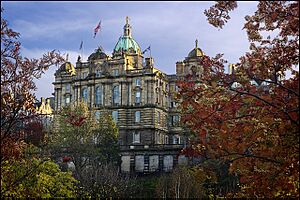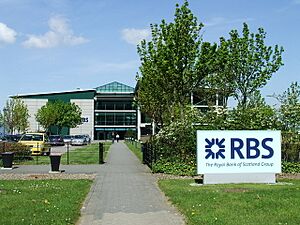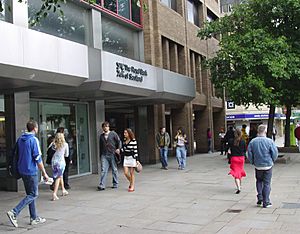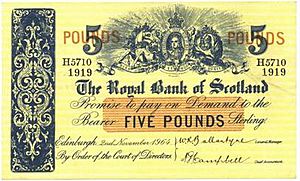Royal Bank of Scotland facts for kids
 |
|

Dundas House in Edinburgh, built in 1774, acquired by the Royal Bank of Scotland in 1821 and still its registered office
|
|
|
Native name
|
Banca Rìoghail na h-Alba
|
|---|---|
| Public limited company1 | |
| Industry | Financial services |
| Founded | 31 May 1727 |
| Headquarters | Edinburgh, Scotland, UK |
|
Key people
|
|
| Services |
|
|
Number of employees
|
71,200 |
| Parent | NatWest Group |
| Footnotes / references 1 Wholly owned subsidiary of NatWest Holdings. |
|
The Royal Bank of Scotland (Scottish Gaelic: Banca Rìoghail na h-Alba) is a major retail and commercial bank in Scotland. It is one of the retail banking subsidiaries of NatWest Group, together with NatWest (in England and Wales) and Ulster Bank. The Royal Bank of Scotland has around 700 branches, mainly in Scotland, though there are branches in many larger towns and cities throughout England and Wales. The bank is completely separate from the fellow Edinburgh-based bank, the Bank of Scotland, which pre-dates the Royal Bank by 32 years. The Royal Bank of Scotland was established to provide a bank with strong Hanoverian and Whig ties.
Following ringfencing of the Group's core domestic business, the bank became a direct subsidiary of NatWest Holdings in 2019. NatWest Markets comprises the Group's investment banking arm. To give it legal form, the former RBS entity was renamed NatWest Markets in 2018; at the same time Adam and Company (which held a separate PRA banking licence) was renamed The Royal Bank of Scotland, with Adam and Company continuing as an RBS private banking brand until 2022.
History
Foundation
The bank traces its origin to the Society of the Subscribed Equivalent Debt, which was set up by investors in the failed Company of Scotland to protect the compensation they received as part of the arrangements of the 1707 Acts of Union. The "Equivalent Society" became the "Equivalent Company" on 21 November 1724, and the new company wished to move into banking. The British government received the request favourably as the "Old Bank", the Bank of Scotland, was suspected of having Jacobite sympathies. Accordingly, the "New Bank" was chartered on 31 May 1727 as the Royal Bank of Scotland, with Archibald Campbell, Lord Ilay, appointed its first governor.
On 31 May 1728, the Royal Bank of Scotland invented the overdraft, which was later considered an innovation in modern banking. It allowed William Hogg, a merchant in the High Street of Edinburgh, access to £1,000 (£111,419 in today's value) credit.
Competition with the Bank of Scotland

Competition between the Old and New Banks was fierce and centred on the issue of banknotes. The policy of the Royal Bank was to either drive the Bank of Scotland out of business or take it over on favourable terms. The Royal Bank built up large holdings of the Bank of Scotland's notes, which it acquired in exchange for its own notes, then suddenly presented to the Bank of Scotland for payment. To pay these notes, the Bank of Scotland was forced to call in its loans and, in March 1728, to suspend payments. The suspension relieved the immediate pressure on the Bank of Scotland at the cost of substantial damage to its reputation and gave the Royal Bank a clear space to expand its own business – although the Royal Bank's increased note issue also made it more vulnerable to the same tactics.
Despite talk of a merger with the Bank of Scotland, the Royal Bank did not possess the wherewithal to complete the deal. By September 1728, the Bank of Scotland was able to start redeeming its notes again, with interest, and in March 1729, it resumed lending. To prevent similar attacks in the future, the Bank of Scotland put an "option clause" on its notes, giving it the right to make the notes interest-bearing while delaying payment for six months; the Royal Bank followed suit. Both banks eventually decided that the policy they had followed was mutually self-destructive and a truce was arranged, but it still took until 1751 before the two banks agreed to accept each other's notes.
Scottish expansion
The bank opened its first branch office outside Edinburgh in 1783 when it opened one in Glasgow, in part of a draper's shop in the High Street. Further branches were opened in Dundee, Rothesay, Dalkeith, Greenock, Port Glasgow, and Leith in the first part of the nineteenth century.
In 1821, the bank moved from its original head office in Edinburgh's Old Town to Dundas House, on St. Andrew Square in the New Town. The building as seen along George Street forms the eastern end of the central vista in New Town. It was designed for Sir Lawrence Dundas by Sir William Chambers as a Palladian mansion, completed in 1774. An axial banking hall (Telling Room) behind the building, designed by John Dick Peddie, was added in 1857; it features a domed roof, painted blue internally, with gold star-shaped coffers. The banking hall continues in use as a branch of the bank, and Dundas House remains the registered head office of the bank to this day.
The rest of the nineteenth century saw the bank pursue mergers with other Scottish banks, chiefly as a response to failing institutions. The assets and liabilities of the Western Bank were acquired following its collapse in 1857; the Dundee Banking Company was acquired in 1864. By 1910, the Royal Bank of Scotland had 158 branches and around 900 staff.
By 1969, economic conditions were becoming more difficult for the banking sector. In response, the Royal Bank of Scotland merged with National Commercial Bank of Scotland. The merger resulted in a new holding company, the National and Commercial Banking Group, with 662 branches in Scotland, which all transferred to the Royal Bank name. The holding company was renamed The Royal Bank of Scotland Group in 1979 and became NatWest Group in July 2020.
Expansion into England

The expansion of the British Empire in the latter half of the nineteenth century saw the emergence of London as the largest financial centre in the world, attracting Scottish banks to expand southward into England. The first London branch of the Royal Bank of Scotland opened in 1874. However, English banks moved to prevent further expansion by Scottish banks into England; and, after a government committee was set up to examine the matter, the Scottish banks chose to drop their expansion plans. An agreement was reached, under which English banks would not open branches in Scotland and Scottish banks would not open branches in England outside London. This agreement remained in place until the 1960s, although various cross-border acquisitions were permitted.
The Royal Bank's English expansion plans were resurrected after World War I when it acquired various small English banks, including London-based Drummonds Bank (in 1924), which continued as a branch of the Royal Bank of Scotland; Williams Deacon's Bank, based in northwestern England (in 1930) and Glyn, Mills & Co. (in 1939), which together came to be known as the Three Banks Group; the English and Welsh branches were reorganised as Williams & Glyn's Bank in 1969, before adopting the Royal Bank name in 1985.
Takeover bids
During the late 1970s and early 1980s, the Royal Bank was the subject of three separate takeover approaches. In 1979, Lloyds Bank, which had previously built up a 16.4% stake in the Royal Bank, made a takeover approach for the remaining shares it did not own. The offer was rejected by the board of directors on the basis that it was detrimental to the bank's operations. However, when the Standard Chartered Bank proposed a merger with the Royal Bank in 1980, the board responded favourably. Standard Chartered Bank was headquartered in London, although most of its operations were in the Far East, and the Royal Bank saw advantages in creating a truly international banking group. Approval was received from the Bank of England, and the two banks agreed to a merger plan that would have seen Standard Chartered acquire the Royal Bank and keep the UK operations based in Edinburgh. However, the bid was scuppered by the Hongkong and Shanghai Banking Corporation (HSBC) which tabled a rival offer. The bid by HSBC was not backed by the Bank of England and was subsequently rejected by the Royal Bank's board. However, the British government referred both bids to the Monopolies and Mergers Commission; both were subsequently rejected as being against the public interest.
The Bank did obtain an international partnership with Banco Santander Central Hispano of Spain, each bank taking a 5% stake in the other. However, this arrangement ended in 2005, when Banco Santander Central Hispano acquired UK bank Abbey National – and both banks sold their respective shareholdings.
International expansion
The first international office of the bank was opened in New York in 1960. Subsequent international banks were opened in Chicago, Los Angeles, Houston, and Hong Kong. In 1988 the bank acquired Citizens Financial Group, a bank based in Rhode Island, United States. Since then, Citizens has acquired several other American banks and in 2004 acquired Charter One Bank.
From 1988 to 2015, it owned Citizens Financial Group, a bank in the United States, and from 2005 to 2009 RBS Group was the second-largest shareholder in the Bank of China, itself the world's fifth-largest bank by market capitalisation in February 2008.
Recent history
Following the implosion of the Royal Bank of Scotland in 2008 while under the direction of directors at its Edinburgh headquarters, and its rescue by taxpayer funds, it became a subsidiary of the UK Government. On 20 January 2011, Royal Bank of Scotland were fined £28.58 million for anti-competitive practices that were enacted with Barclays in relation to the pricing of loan products for large professional services firms. Also in 2011, Royal Bank of Scotland prevented Basic Account holders from using the ATMs of most rival banks (although they could still use those of NatWest, Tesco, Morrisons and the Post Office).
In June 2012, computer problems prevented customers accessing accounts. Royal Bank of Scotland released a statement on 12 June 2013 that announced a transition in which CEO Stephen Hester would stand down in December 2013 for the financial institution "to return to private ownership by the end of 2014". For his part in the procession of the transition, Hester received 12 months' pay and benefits worth £1.6 million, as well as the potential for £4 million in shares. The Royal Bank of Scotland stated that, as of the announcement, the search for Hester's successor would commence. Hester was replaced as CEO by New Zealander Ross McEwan, formerly the head of the bank's retail arm, on 1 October 2013. McEwan, who was 56 years old at the start of his tenure, will receive no bonus for his work in 2013 or at the end of 2014, and his pension will be replaced by an annual cash sum equivalent to 35 percent of his salary as CEO.
In November 2013, Royal Bank of Scotland announced it was in talks to sell a shipping loan in ’Eagle Bulk Shipping Inc.’ worth $800 million. It was also announced in that month that the bank was in talks to sell its equity derivatives business to a buyer rumoured to be BNP Paribas. In September 2014, Royal Bank of Scotland announced that they would move their headquarters to London in the event of a Yes vote in the Scottish referendum. Whilst this move would not affect day to day banking services in Scotland, there would be several major ramifications; the key issue being that the Scottish version of Royal Bank of Scotland would become a subsidiary to the London-based holding company. Therefore, tax would be paid chiefly through the London-based company, thus depriving Scotland of significant revenues. This would break a near 300-year period in which the Royal Bank of Scotland has been headquartered in Edinburgh. In March 2015, Royal Bank of Scotland agreed to sell its internationally managed private banking and wealth management business to Switzerland's Union Bancaire Privée UBP SA. The sale includes client relationships managed under Coutts and Adam and Company brands in Switzerland, Monaco, the UAE, Qatar, Singapore and Hong Kong. The terms of the sale were not announced. The operations being sold has CHF 32-billion of client assets under management. Royal Bank of Scotland will continue to offer private banking and wealth management in the British Isles, as well as to international clients with a strong connection to the UK.

On 20 March 2017, the British paper The Guardian reported that hundreds of banks had helped launder KGB-related funds out of Russia, as uncovered by an investigation named Global Laundromat. The Royal Bank of Scotland was listed among the 17 banks in the UK that were "facing questions over what they knew about the international scheme and why they did not turn away suspicious money transfers," as the bank "handled $113.1 million" in Laundromat cash. Other banks facing scrutiny under the investigation included HSBC, NatWest, Lloyds, Barclays and Coutts. Coutts, owned by RBS, had "accepted $32.8m worth of payments via its office in Zürich, Switzerland." NatWest, also owned by RBS, was named for allowing through $1.1 million in related funds. In early 2018, The Royal Bank of Scotland Group announced its plans for restructuring to comply with new UK-wide rules on ring-fencing retail banking operations from riskier investment banking operations. As part of this restructuring, all retail banking assets of the existing Royal Bank of Scotland were transferred to Adam and Company, which assumed the Royal Bank of Scotland name in the process. Adam and Company continued as an RBS private banking brand in Scotland, along the same lines as the Messrs. Drummond and Child & Co. businesses in England. As part of the restructuring and brand management, it was decided that NatWest would become RBS Group's primary customer-facing brand in England and Wales. As a result, all Royal Bank of Scotland branded branches in England and Wales were closed as they were located close to NatWest branded branches, which customers would be able to use for counter services instead.
On 14 February 2020, it was announced that the holding company of Royal Bank of Scotland (Royal Bank of Scotland Group plc) would be renamed NatWest Group plc later that year, taking the brand under which the majority of its business is delivered. The change took place on 22 July 2020. The investment management business of Adam and Company was acquired by Canaccord Genuity Group in 2021 and its banking and lending business transferred to Coutts & Co. in 2022 using a banking business transfer scheme approved by the Court of Session in Edinburgh. Child & Co. also closed in 2022, leaving Messrs. Drummond and Holt's Military Banking as the only remaining branches of RBS operating in England and Wales.
Proposed Williams and Glyn divestment
As a consequence of the British Government taking an 81% shareholding in the RBS Group following the 2007–2008 financial crisis, the group was required by a European Commission ruling to sell a portion of its business, as the commission regarded the shareholding as state aid.
Royal Bank of Scotland unveiled plans in 2009 to resurrect the dormant Williams and Glyn's brand name in preparation for the divestment of its Royal Bank of Scotland-branded retail banking business in England and its NatWest branches in Scotland.
On 27 September 2013, the Royal Bank of Scotland Group confirmed it had agreed to sell 308 Royal Bank of Scotland branches in England and Wales and 6 NatWest branches in Scotland to the Corsair consortium. The branches were due to be divested from the group in 2016 as a standalone business operating under the Williams & Glyn name, although, in August 2016, RBS cancelled the spin-off plan, stating that the new bank could not survive independently. It revealed it would instead seek to sell the division to another bank.
In February 2017, HM Treasury suggested that the bank should abandon the plan to sell the division, and instead focus on initiatives to boost competition within business banking in the United Kingdom. The plan would be subject to approval by the European Commission. A final agreement, known as the "Alternative Remedies Package", was reached with the European Commission in September 2017, allowing RBS Group to retain the Williams & Glyn assets and bringing the sale process to a close.
In May 2018, it was announced that 162 RBS branches in England or Wales that were to have become Williams & Glyn would be closed, resulting in almost 800 job losses, with customers able to use nearby NatWest branches for counter services instead. The closure of a further 54 branches was announced in September 2018 with an expected loss of 258 jobs.
Banknotes
Up until the middle of the 19th century, privately owned banks in Great Britain and Ireland were permitted to issue their own banknotes, and money issued by provincial Scottish, English, Welsh and Irish banking companies circulated freely as a means of payment. While the Bank of England eventually gained a monopoly for issuing banknotes in England and Wales, Scottish banks retained the right to issue their own banknotes and continue to do so to this day. The Royal Bank of Scotland, along with Clydesdale Bank and Bank of Scotland, still prints its own banknotes.
Notes issued by Scottish banks circulate widely and may be used as a means of payment throughout Scotland and the rest of the United Kingdom; although they do not have the status of legal tender they are accepted as promissory notes. No paper money is legal tender in Scotland, even that issued by the Bank of England (which is legal tender in England and Wales).
“Fabric of Nature” series (2016)
From May 2020 RBS began to replace the “Ilay” series with the new “Fabric of Nature” series of polymer banknotes. The first polymer notes, the £5, came into circulation on 27 October 2016. The £5 note features Nan Shepherd on the obverse accompanied by a quote from her book 'The Living Mountain', and the Cairngorms in the background. The reverse shows a pair of mackerel, with an excerpt from the poem ‘The Choice’ by Sorley MacLean.
The second polymer note to be introduced was the £10 note, which entered circulation in 2017. It shows Mary Somerville on the obverse, with a quote from her work 'The Connection of the Physical Sciences', and Burntisland beach in the background. The reverse displays two otters and an excerpt from the poem ‘Moorings’ by Norman MacCaig.
"Ilay" series (1987)
Prior to the current polymer series, the Royal Bank "Ilay" series of banknotes were in circulation, so-called because each denomination featured a picture of Lord Ilay (1682–1761), the first governor of the bank. The image was based on a portrait of Lord Ilay painted in 1744 by the Edinburgh artist Allan Ramsay.
The front of the notes also included an engraving of the facade of Dundas House, the mansion of Sir Laurence Dundas in St. Andrew Square, Edinburgh, which was built by Sir William Chambers in 1774 and later became the bank's headquarters; the bank's coat of arms; and the 1969 arrows logo and branding. The background graphic on both sides of the notes was a radial star design which was based on the ornate ceiling of the banking hall in the old headquarters building, designed by John Dick Peddie in 1857.
On the back of the notes were images of Scottish castles, with a different castle for each denomination:
- 1 pound note featuring Edinburgh Castle
- 5 pound note featuring Culzean Castle
- 10 pound note featuring Glamis Castle
- 20 pound note featuring Brodick Castle
- 50 pound note featuring Inverness Castle (introduced in 2005)
- 100 pound note featuring Balmoral Castle
As of 30 September 2022 the Ilay series was withdrawn, along with all non-polymer banknotes in the United Kingdom.
Commemorative banknotes
Occasionally the Royal Bank of Scotland issues special commemorative banknotes to mark particular occasions or to celebrate famous people. The Royal Bank was the first British bank to print commemorative banknotes in 1992 followed by several subsequent special issues. These notes are much sought-after by collectors and they rarely remain long in circulation. Examples to date have included:
- a £1 note to mark the meeting of the Council of the European Union in Holyrood Palace during the UK's Presidency of the Council of the European Union (1992)
- a £1 note to mark the 100th Anniversary of the death of Robert Louis Stevenson (1994)
- a £1 note to mark the 150th Anniversary of the birth of Alexander Graham Bell (1997)
- a £20 note for the 100th birthday of Queen Elizabeth The Queen Mother (2000)
- a £5 note honouring veteran golfer Jack Nicklaus in his last competitive Open Championship at St Andrews (2005).
- a £1 note to mark the opening of the Scottish Parliament, depicting the General Assembly Hall of the Church of Scotland, the temporary home of the parliament, and a diagram of the floorplan of the new parliament building, designed by Enric Miralles (1999)
- a £50 note to mark the opening of the Royal Bank of Scotland's new headquarters in Gogarburn (2005)
- a £10 note to commemorate the Diamond Jubilee of Elizabeth II. On the reverse of the commemorative note are four intaglio portraits of Elizabeth II, showing her at different stages of her life (2012)
- a £5 note to commemorate the Ryder Cup. It is printed by Giesecke+Devrient on the "Hybrid" substrate.
Services
The Royal Bank of Scotland provides a full range of banking and insurance services to personal, business, and commercial customers. As well as traditional branches, phone, and internet banking, Royal Bank of Scotland has operated "mobile branches" since 1946 using converted vans to serve rural areas. There are currently 19 mobile branches.
The bank is authorised by the Prudential Regulation Authority and regulated by both the Financial Conduct Authority and the Prudential Regulation Authority. It participates fully in the Faster Payments Service, an initiative to speed up certain payments, launched in 2008.
In 2006, The Royal Bank of Scotland Group undertook the first trial of PayPass contactless debit and credit cards in Europe. The bank is introducing Visa Debit cards with the technology for current accounts, which can be used to pay for purchases up to £30 by tapping an enabled card on the retailer's terminal. In an effort to enhance security, Royal Bank of Scotland and NatWest introduced hand-held devices in 2007 for use with a card to authorise online banking transactions.
Royal Bank of Scotland is a member of the Cheque and Credit Clearing Company Limited, Bankers' Automated Clearing Services Limited, the Clearing House Automated Payment System Limited and the LINK Interchange Network Limited. It is a member of the Financial Ombudsman Service, UK Payments Administration and of the British Bankers' Association; it subscribes to the Lending Code. The bank is covered by the Financial Services Compensation Scheme with The One account, Drummonds Bank and Holt's Military Banking under one licence.
Branding
The Royal Bank of Scotland Group uses branding developed for the Bank on its merger with the National Commercial Bank of Scotland in 1969. The Group's logo takes the form of an abstract symbol of four inward-pointing arrows known as the "Daisy Wheel" and is based on an arrangement of 36 piles of coins in a 6 by 6 square, representing the accumulation and concentration of wealth by the Group. The Daisy Wheel logo was later adopted by Royal Bank of Scotland Group subsidiaries Ulster Bank in Ireland, Citizens Financial Group in the United States and, until it was sold in 2010, payment processing company Worldpay.
From 2003, the bank began to move away from referring to both the Group brand and its retail banking brand as "The Royal Bank of Scotland", instead of using the "RBS" initialism. This was intended to support the positioning of the bank as a Global financial services player as opposed to its roots as a national bank, however, "The Royal Bank of Scotland" continued to be used alongside the RBS initialism, with both appearing on bank signage.
In spring 2014 the full bank name returned to print and television advertising in the form of a new logo with the omission of "The". In August 2016, Ross McEwan confirmed that the bank would use the full name for its business in Scotland in lieu of the RBS acronym, to distance the bank from its previous global expansion plans.
Royal Bank of Scotland sponsored the Williams F1 team from 2005 until the end of 2010. They also were the title sponsor for the Canadian Grand Prix from 2005 until the end of 2008. They have supported tennis player Andy Murray since he was aged 13.
See also
- List of investors in Bernard L. Madoff Investment Securities









